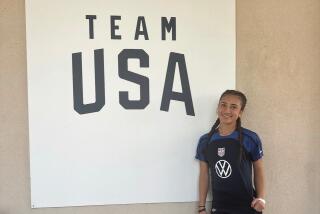Game for Learning : Santa Monica High Basketball Players Embrace Tutoring Program
Susan Wilson walked into the cafeteria at Santa Monica High a few weeks ago and finally saw the product of a year’s work.
She scanned the room, table after table, observing loud teenagers free from teachers and lectures. There was nothing different about this lunch period, except for what she saw as she was about to walk out the door.
“It was one of our basketball players,” she said. “It was one of the players who had had some trouble in class and had been academically ineligible before. He was sitting at a table by himself reading ‘Of Mice and Men.’ ”
It is not that athletes at Santa Monica had run from the bookmobile or burned their library cards, but like at any high school, some of the athletes, well, had been content just being athletes.
That was before basketball Coach James Hecht took over two years ago, before he got Wilson to implement an academic assistance program for the boys’ basketball teams and before the Hecht way became the law at Santa Monica High.
“Coach came in right away and let it be known that, from the freshman team to the varsity, it was academics first,” Wilson said. “He made it clear in the summer when he started working out with the kids that academics was first.
“He was so serious that the kids who were not willing to commit themselves didn’t even bother to try out for the team.”
The impression was the easy part. The difficulty at Santa Monica was getting the players to adhere to the plan Hecht and Wilson had set.
Virtually every school has a tutoring program. Schools such as Dorsey, Westchester and Long Beach Poly have had great success in preparing athletes for college. And Culver City High has several UCLA students come over every Thursday night to tutor basketball players.
But any school will attest that just making help available doesn’t assure athletes will use it.
Wilson designed the Santa Monica program with that in mind. With help from the athletic tutorial program at UCLA, she compiled ideas and approached Hecht with an outline.
The Santa Monica athletic department took the first step, pooling funds from its concession stands and hiring a student from UCLA to tutor the basketball teams. Officials tried to make the tutor available whenever the players asked, and even doubled the time during finals.
Also, with both gymnasiums at Santa Monica closed for remodeling, the team has had to practice at a middle school, usually beginning at 6:30 instead of right after classes. Hecht used the time to his advantage, making sure a classroom was left open and that someone was available to tutor the players during the three hours before practice.
The players also have to turn in progress reports each week so Wilson and the coaches could target need areas and get the player assistance with the subject.
In addition, Hecht, who also teaches math at Santa Monica, made it clear that a player who was having trouble in a class would be attending the tutoring sessions available to all students on Saturdays.
“The change I have seen now is that players have started asking for help,” said Hecht. “They ask when the tutor is coming. The hardest thing for kids sometimes is to admit they need help.”
That was the case for junior Keyon Smith, who was having trouble with geometry before Hecht began the tutoring program.
“Before, I needed help but sometimes I was just afraid to ask,” Smith said. “I didn’t want people to think I was stupid.
“At other schools, they look at it as either you are eligible or not. That’s it. Here I know they care about how I am doing.”
Said Wilson: “When my daughter comes home I can ask her about tests and homework, but we have so many kids that don’t get asked. Now there are a number of people who pay attention to these kids.”
Santa Monica’s commitment to its athletes is even more important considering the lack of other free assistance available in Los Angeles.
Frank DuBois, the educational director for the Nike basketball camp, and Forrest Harris, the president of the nonprofit Foundation for Student Athletes in Chicago, used to hold educational summer camps for athletes in Los Angeles and Chicago.
Coaches and teachers would work with athletes on their writing skills and tutor them in the type of math and grammar questions they would face on the Scholastic Assessment Test. But in 1985, their foundation, then called the Athletes for a Better Education, stopped the camps in Los Angeles.
“We just ran out of money,” DuBois said. “It seemed to me it was really hard to get funding out west. It was like pulling teeth.”
DuBois still works in camps and clinics in Chicago and for Nike; and Harris’ Foundation for Student Athletes works with athletes in Chicago grammar schools.
In New York, filmmaker Spike Lee runs a camp that helps prepare athletes for the SAT and the college application process; and Leonard Genova, executive director of Athletes and Academics Equals Success, runs three or four clinics a year with 120-150 athletes.
But in Los Angeles there is little available for an athlete, other than paying tutors or using commercial educational firms that cost large sums of money.
“It seems like the athletes that most need the help are the ones who don’t have the money to pay for it,” Genova said. “If they don’t have another option, then it only hurts their chances of graduating or being eligible for college.”
But Santa Monica has not only given its players an option, it has demanded they take advantage of it. And the result has been better then even Hecht or Wilson could have expected.
All of the varsity players remained eligible this season, and the freshmen and junior varsity squads have even higher marks. The lowest grade-point-average on the freshmen team is a 2.8 and several players earned a 4.0. Hecht sees it as a sign of good things to come.
“As each year passes, I see the effect in the younger kids,” he said. “In the next few years, when they come up [to the varsity] they will know what is expected of them.”
Though the basketball teams are finding themselves academically, they still are searching for a winning combination on the court. The Vikings finished 11-13 this season, fifth in the Bay League with a 6-8 record.
Hecht, who played at St. Monica’s and Cal State Northridge from 1984-88, hears those numbers and shrugs.
“I want to win as much as any coach,” he said. “But I think we are doing it the right way. I think if we were a little more successful but not as attentive to academics and how the kids are as young men, we would be shortchanging them.”
Hecht’s approach is spreading at Santa Monica, with the girls’ basketball coaches thinking about starting a similar plan for their athletes.
“I know what we have done is nothing new, and I don’t want to appear as some guru,” Hecht said. “I want to help the athletes here become better basketball players. But we have some kids who are starting to believe in themselves academically, and that is what is most important.”
More to Read
Get our high school sports newsletter
Prep Rally is devoted to the SoCal high school sports experience, bringing you scores, stories and a behind-the-scenes look at what makes prep sports so popular.
You may occasionally receive promotional content from the Los Angeles Times.





